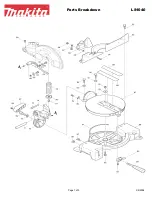
PAHE 20-Li A1
■
46
│
GB
│
MT
f)
Dress properly. Do not wear loose clothing or
jewellery. Keep your hair, clothing and gloves
away from moving parts.
Loose clothes, jewel-
lery or long hair can be caught in moving parts.
g)
If devices are provided for the connection of
dust extraction and collection facilities, ensure
these are connected and properly used.
Use
of dust collection systems can can reduce dust-
related hazards.
4. Power tool use and care
a)
Do not force the power tool. Use the correct
power tool for your application.
The correct
power tool will do the job better and safer at
the rate for which it was designed.
b)
Do not use the power tool if the switch is
defective.
Any power tool that cannot be
controlled with the switch is dangerous and
must be repaired.
c)
Disconnect the plug from the power source
and/or the battery pack from the power tool
before making any adjustments, changing
accessories, or storing power tools.
Such
preventive safety measures reduce the risk of
starting the power tool accidentally.
d)
Store idle power tools out of the reach of
children. Do not allow persons unfamiliar
with the power tool or these instructions to
operate the power tool.
Power tools are
dangerous in the hands of untrained users.
e)
Maintain power tools. Check for misalignment
or binding of moving parts, breakage of parts
and any other condition that may affect the
power tool’s operation. If damaged, have
the power tool repaired before use.
Many
accidents are caused by poorly maintained
power tools.
f)
Keep cutting tools sharp and clean.
Properly
maintained cutting tools with sharp cutting edges
are less likely to bind and are easier to control.
g)
Use the power tool, accessories and tool bits
etc. in accordance with these instructions,
taking into account the working conditions
and the work to be performed.
Use of the
power tool for operations other from those
intended could result in a hazardous situation.
5. Use and handling of the cableless
electrical power tool
a)
Charge a rechargeable battery unit using
only the charger recommended by the manu-
facturer.
Chargers are often designed for a
particular type of rechargeable battery. There
is a risk of fire if other types of rechargeable
battery are used.
b)
Only the rechargeable battery units supplied
are to be used with the power tools.
The use
of other rechargeable battery units may lead
to the danger of injury or fire.
c)
When they are not being used, store re-
chargeable battery units away from paper
clips, coins, keys. nails, screws or other small
metal objects that could cause the contacts to
be bridged.
Short-circuiting the contacts of a
rechargeable battery may result in burns or fire.
d)
Fluid may leak out of rechargeable batteries
if they are misused. If this happens, avoid
contact with the fluid. If accidental contact oc-
curs, rinse the affected area with water. Seek
additional medical help if any of the fluid
gets into your eyes.
Escaping battery fluid may
cause skin irritation or burns.
CAUTION! RISK OF EXPLOSION!
Never charge non-rechargeable
batteries.
Protect the battery from heat, e.g.
also from continuous sunlight, fire,
water and humidity.
There is a risk of
explosion.
6. Service
a)
Have your power tool serviced by a qualified
repair person using only original replacement
parts.
This will ensure that the safety of the
power tool is maintained.
















































